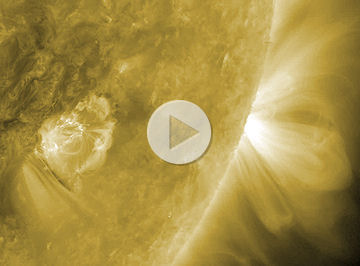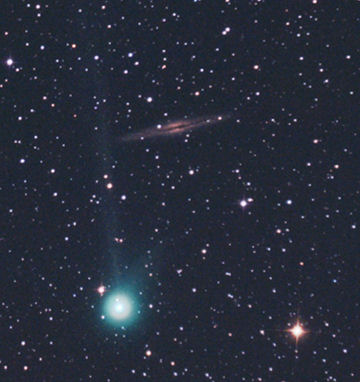NEW AND IMPROVED: Turn your iPhone or iPod Touch into a field-tested global satellite tracker. The Satellite Flybys app now works in all countries. | | | AURORA WATCH: NOAA forecasters estimate a 60% chance of geomagnetic activity today when a solar wind stream is expected to hit Earth's magnetic field. High latitude sky watchers should be alert for auroras. CRACKLING SUNSPOT: New sunspot 1078 is growing rapidly and crackling with low-level solar flares. Click on the image to view some of the action recorded on June 8th by NASA's Solar Dynamics Observatory (SDO): 
movie formats: 1.8 MB mpg; 1 MB iPad; 0.6 MB iPhone
So far the relatively minor "crackles" shown in the SDO movie have had no effect on Earth. If the active region continues to grow, however, the flares could become more intense, leading to waves of ionization in Earth's upper atmosphere and disturbances in low-frequency radio propagation. Stay tuned. COMET MCNAUGHT: A fresh comet is swinging through the inner solar system, and it is brightening rapidly as it approaches the sun. Presenting, Comet McNaught (C/2009 R1): 
Amateur astronomer John Chumack of Yellow Springs, Ohio, caught the comet passing by galaxy NGC 891 just before sunrise on June 8th. "I used a 5.5 inch telescope and a Canon Rebel Xsi digital camera to take this 15 minute exposure," he says. "It also looked great through binoculars." Comet McNaught can be found low in the northeastern sky before dawn gliding through the constellation Perseus. It is brightening as it approaches Earth for a 1.13 AU close encounter on June 15th and 16th. Currently, the comet is at the threshold of naked eye visibility (6th magnitude) and could become as bright as the stars of the Big Dipper (2nd magnitude) before the end of the month. Because this is the comet's first visit to the inner solar system, predictions of future brightness are necessarily uncertain; amateur astronomers should be alert for the unexpected. [ephemeris] [3D orbit] [Sky & Telescope: sky map, full story] more images: from Dr Paolo Candy of Ci.A.O. Cimini Astronomical Observatory, Italy; from Michael Jäger of Stixendorf, Austria; from Anthony Ayiomamitis of Athens, Greece; from Primoz Cigler of Bohor, Slovenia; from Pete Lawrence of Selsey, West Sussex, UK; from Feys Filip at the Public Observatory "Sasteria" in Crete; from Monika Landy-Gyebnar of Veszprem, Hungary; from Petr Horalek of Ustupky, Czech republic;
May 2010 Aurora Gallery
[previous Mays: 2008, 2005, 2004, 2003, 2002] [aurora alerts] | 
